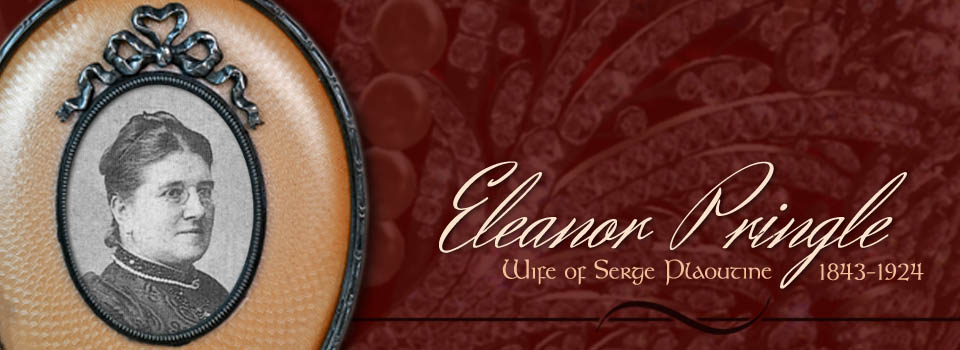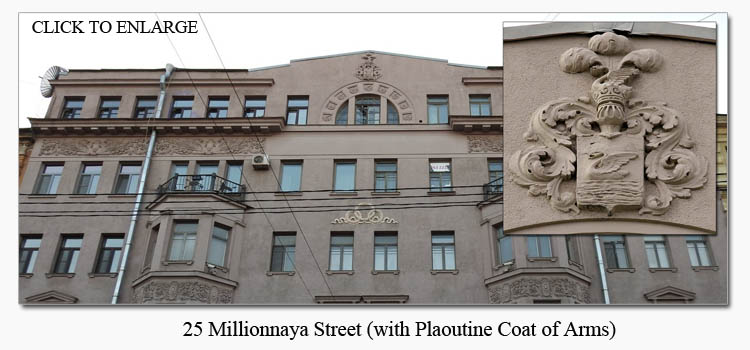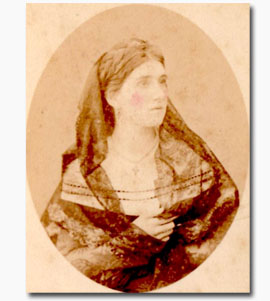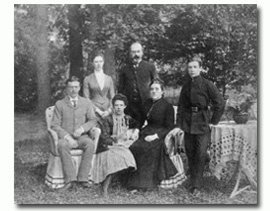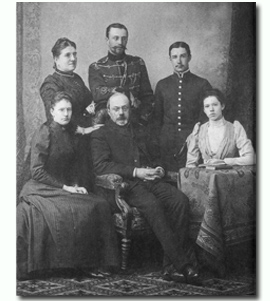Eleanor Hester Mary Pringle (1843 - 1924)
Eleanor was the fourth child and second daughter of John Pringle and Georgiana Ramsbottom, known to family and friends as "Nell".
Nell Pringle was born in London on 14 Sep 1843 and baptized at St. George's in Ramsgate, Kent, on the 19th of November. Much of her childhood was passed in France (especially in Paris), and Nell and her siblings were as fluent in French as they were in English. As a senior officer in the Coldstream Guards (during a rather peaceful time in British history), Nell's father had plenty of time to travel and a fondness for the Continent (where he and his family spent as many as six months out of each year). Claire Clairmont (a close family friend) was always full of praises for the Pringle children, calling them "lovely and pretty . . . and so full of character — so clever and independent, but so soft and affectionate — not a jot will they yield if they are harshly treated, but will for kindness, or a kind look, do the most impossible tasks". Young "Elly" is referred to in a number of Clairmont's letters.
Nell lived with not only her parents and six siblings but also her maternal grandmother and aunt (they all appear together on the 1851 census, living in London at 13 Kensington Gardens). The whole family moved a number of times, and, in early 1860, the family found a new home at 3 Queen's Gate Terrace. At the same time, Nell (along with both of her sisters) was elected as a Fellow of the London Horticultural Society. This was more of a social club at this time than an exhibition of horticultural passion, but (if Nell or her sisters did care to try their hand at any gardening) they were entitled to use of the society's private acreage for the use of its members.
Shortly before her eighteenth birthday, as the daughter of a high-ranking Army Officer, Nell was presented (by her mother, as a matter of fact) to Queen Victoria at Her Majesty's Drawing Room of June 1861. Days later, Nell's older sister (Violet) married, leaving Nell to accompany her parents to various balls, assemblies and fetes as Miss Pringle. This was the beginning of six years spent circulating in London's high society, after which time the papers announced that "one of the reigning blonde beauties of London", Miss Eleanor Pringle, was married to Colonel Serge Plaoutine, Aide-de-Camp to H.M. the Tsar of Russia. They were married at the Church of the Holy Trinity in Nice, France, on 30 Apr 1867, and were blessed with four children (two sons and two daughters).
The Plaoutines continued on at Nice, and it was there, on the second day of February in 1868, that Eleanor gave birth to their first child, Nicholas. The next two children were born in Russia at Tsarskoe-Selo, the youngest in St. Petersburg. Eleanor and Serge eventually settled their family at 24 Quai De La Cour (also known as the Winter Palace Embankment) in St. Petersburg, a large mansion house, owned by the Plaoutines, standing beside the palace of Grand Duke Vladimir and opposite the St. Peter and Paul Cathedral.* For the periods when city life was undesirable, the Plaoutines also had a country estate within a forty-five-minute journey from St. Petersburg (as referenced in family letters, the exact location most unfortunately never mentioned).
By Spring of 1883, Lt-General Serge Plaoutine has retired from active duty in the Russian Army and moved his family to Brighton. Although the primary reason for this move was to establish residence in England and enroll the eldest son in Brighton College, it had the added (and no less important) bonus of providing Nell with many opportunities to enjoy her English family. In fact, she was actually present at the marriages of two of her younger siblings. Serge rented a flat at 47 Marine-parade in Brighton, where the family enjoyed "four of the happiest years" of young Lily's life. Nicholas left Brighton College in 1886, and the family returned to Russia, everafter maintaing a close relationship with Nell's family in England. (Her younger sister, Blanche, was early-on widowed with two very young children, and they often visited "Aunt Nell and Uncle Serge" in both Russia and Nice.)
Eleanor and Serge circulated in the highest Russian society, giving and attending balls, and they were on intimate terms with the members of the Tsar's Court. They also spent a lot of time travelling to more temperate climates, where family trips were made to Menton, Florence, Saltino and Nice. From about 1907 onwards, the Plaoutines rented one flat at the Chateau St. Laurent in Nice, finally retiring there in 1914 and leaving St. Petersburg for good. It does not appear that they ever returned to Russia but lived in the second- story flat at Chateau St. Laurent for the remainder of their lives.
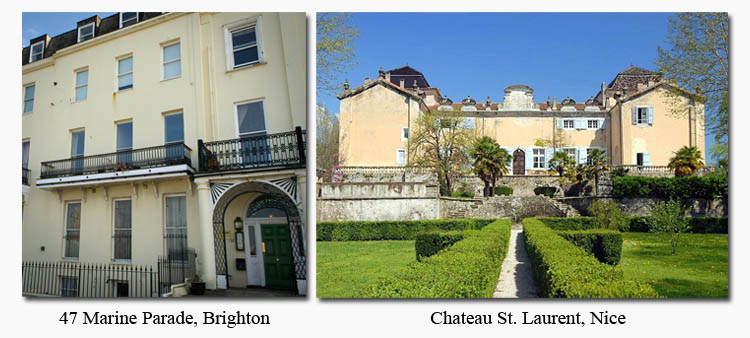
Nell shared a keen interest in paleontology with her husband, and together they discovered quite a few new species of fossils (mostly trilobites). Eleanor herself first found and named a species of echinoderms called "Cyathocystis plautinae". They also had a very large and admired collection of mounted birds from many different countries around the world.
After their retirement to Nice, Nell seems to have led a very quiet life. To the sorrow of her family, the older daughter still in Russia, Vera, died in May 1917 of pneumonia. Because of the looming Bolshevik Revolution, Vera's three young daughters were sent for safety to the Chateau St. Laurent. There they lived with their grandparents for many years, leaving only as they married or found employment away from home. During the warm summer months, Nell and Serge would take their granddaughters to Royat, a French watering place in the Auvergne.
Nell's life was shattered with the coming of the Russian Revolution. All three of her remaining children died in sad circumstances, one of the black pox and two were murdered by the Bolsheviks. Five of her grandchildren died as a result of the uprising (from either illness or shootings), and two others disappeared, changed their names, and lost all contact with the family.
Until 1917, Michael Plaoutine, Serge and Nell's younger son, had controlled his father's estates back in Russia and sent regular payments to his parents in Nice. At the beginning of the Revolution, however, the money ceased to come, and Serge had to cope with the loss of not only his beloved family but a vast fortune left behind in Russia. He had not carried much of value with him to Nice, as he wholeheartedly believed in the future of Russia as he knew it, and now it had all been stolen by the Bolsheviks. It was only thanks to the kindness of a distant cousin in England that Nell and Serge were able to continue on in their home in Nice. What a horrible experience it must have been for Nell, after a lifetime filled with comforts, family and all that the high society of Imperial Russia could offer, to lose everything. How sad it is that she had to spend her later years in exile, childless, and supported by a cousin.
By the summer of 1924, Nell's health was failing. She was too ill to make the usual summer journey into the mountains at St. Martin-Vesubie, and spent her last days confined to her bedroom, dying there on 1 Oct 1924 at the age of 81. She was buried at the Ste Marguerite Anglo-American Cemetery, not far from her home at Chateau St. Laurent. A large flat stone with a cross and deteriorating inscription still marks the spot of her final resting place.

* The Plaoutines’ house at 24 Quai de la Cour was a grand property, particularly unique since Serge owned the complete building. This meant that his house stretched from Quai de la Cour to Millionnaya Street (commonly called a “double front” house), so that he actually had another address in St. Petersburg, at 25 Millionnaya Street. The house was reconstructed at his orders in 1913, and the Plaoutine coat of arms can still be seen at the top of the very impressive Millionnaya Street side of the building.
